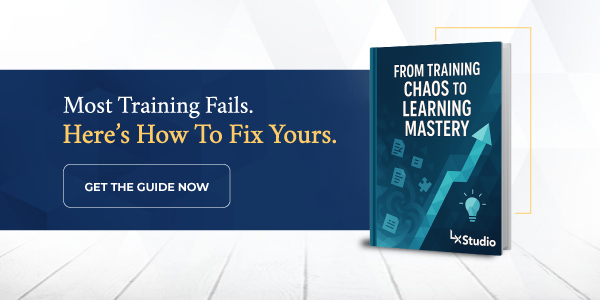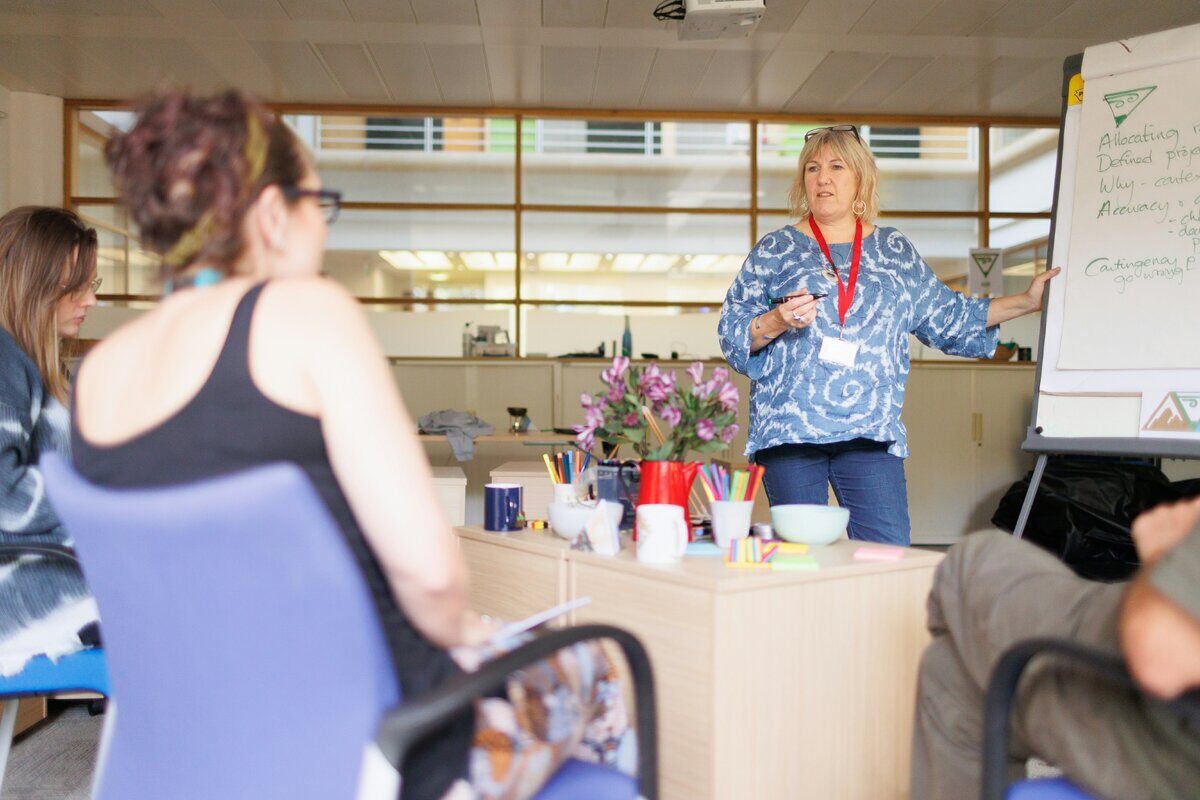
From Plan to Practice: Mastering the Art of Training Implementation
According to one recent study, the global market size of the workplace training industry hit a massive $401 billion in 2024 alone.
This growth has been taking place to some degree since 2009, and it shows no signs of slowing anytime soon.
Part of this has to do with the myriad of different benefits that workplace training brings with it.
92% of employees say that training programs that are well-planned have a "favorable impact on their level of engagement."
The more engaged an employee is, the more productive - and profitable - they tend to be.
94% of employees also say that they would stay with a business for a longer period than they were planning if they were involved in their own learning and development.
So whether yours is a business dealing with disengaged employees, high turnover, a skills gap, or something else entirely, the right training implementation can address all these issues and more.
But at the same time, knowing that these things are important is one thing.
Doing something about them is something else entirely.
If you truly want to go from plan to practice and master the art of training implementation and program rollout, there are a number of critical things you must keep in mind.
Planning for Smooth Program Rollout
The number one thing to acknowledge about training implementation is the idea that this isn't something you'll just "do once and be done with."
Program rollout requires careful planning well in advance of the "go-live" date you've put on the calendar.
For example - how do you know what "success" actually looks like?
Answering that question will require you to develop clear objectives and goals as early on in this process as possible.
Establish specific, measurable, achievable, relevant, and time-bound (SMART) goals for the training program.
These goals should align with organizational priorities and desired outcomes, such as improved productivity, enhanced skills, or compliance adherence.
How long should your training take to complete before you start to see some type of value from your efforts?
Answering this question will require you to put together a detailed timeline and set of milestones for your training before it actually begins.
Develop a comprehensive timeline that includes key milestones, deadlines, and activities for each phase of the program.
This timeline should account for preparation, execution, feedback collection, and evaluation.
As you can see, planning for a smooth program rollout will involve a great deal more than most realize.
Even a modest training program can quickly become quite large in scope, which can often give way to organizational resistance if you're not careful.
Employees might resist new processes or tools, which can affect the success of the program.
Regardless, you need to involve leadership early and make sure that everyone understands why this training is important and the benefits it will bring with it.
Their endorsement and support can help drive buy-in from employees and motivate them to participate fully.
In terms of getting everyone onboard with the amount of effort that will be required to implement this program in the first place, be sure to communicate the "why" of it all as clearly and as frequently as possible.
You must be able to articulate both the purpose and benefits of the training program.
Show employees how the program aligns with their personal growth, team objectives, and company goals.
When it comes to effective communication, be sure to utilize a variety of communication methods to get your points across.
That includes not only email and meetings but also newsletters, social posts, and more.
All this will help keep employees informed, which will go a long way towards keeping them engaged as well.
You should also be prepared to offer frequent updates about not just how the rollout is going, but where you are in the timeline, when key milestones are being hit, and more.
This level of transparency will help reduce uncertainty during program rollout, which is a leading cause of fear regarding training implementation in the first place.
But more than anything, you must acknowledge that this time will be a two-way street.
You're not simply saying "here is what we're doing, and this program is going to go ahead whether you like it or not."
Foster a culture of two-way communication by allowing employees to provide feedback, ask questions, and raise concerns throughout the rollout.
It will make them feel included in a process that impacts them greatly, which will help improve their engagement with it as well.
Before you know it, they'll be rooting for it to succeed - which is an excellent position to be in.
Training Facilitators and Support Staff
In a larger sense, one must acknowledge that the success of any workplace training program will depend heavily on the facilitators and support staff who lead it.
That is to say, you could have what is objectively the best and most helpful course materials in the world, and it ultimately won't mean a thing if the people in charge of distributing it aren't up to the task.
One of the easiest ways to do this is to focus on the core competencies that facilitators need as they relate to the goals your organization is trying to accomplish.
Identify key attributes of an effective facilitator, such as strong communication skills, expertise in the subject, adaptability, and empathy.
Facilitators should be able to create an inclusive learning environment that supports diverse learning styles.
Facilitator guides will also quickly become essential for maintaining consistency across sessions and ensuring all facilitators deliver the program content effectively.
Create an agenda and timeline that includes clear session agendas, time allocation, and objectives for each segment of the training.
Make sure that facilitators understand what the specific goal of each session is supposed to be so they can focus on the most important content.
Provide facilitators with training materials, slides, handouts, case studies, and exercises that they can use during the session.
Include instructions on how to engage learners and facilitate discussions.
On the one hand, it does seem a little odd to "train" the people who are themselves going to be training the next generation of your workforce.
But this is absolutely one of those situations where the results will soon speak for themselves.
The Power of Iterative, Collaborative Development
At this point, it's important to acknowledge the benefits of iterative development as it relates to training implementation.
That is to say, you should look at your training and education program as something that is always evolving.
It's never "done," because you'll never run out of ways to make it better and improve upon the already impressive results that you've seen.
Traditional linear development processes, where training content is created and rolled out in a one-time, top-down fashion, can be restrictive and fail to meet the needs of the target audience.
They often end up being far too rigid for their own good.
Making changes is difficult, meaning the program itself won't be able to adapt as your business needs to do the same.
They typically don't have processes in place to solicit feedback from learners, and key stakeholders are rarely as involved as they should be.
An iterative process, on the other hand, provides faster feedback and increased collaboration.
But crucially, it also enables dramatically improved learner engagement, too.
When learners feel their feedback is valued and incorporated into the training process, they are more likely to be engaged and motivated.
Continuous iteration can help tailor the program to different learning preferences.
Feedback loops where you regularly collect input from all key stakeholders and collaborative content creation are just two of the techniques you can use to involve people throughout this process.
Adapting to Different Delivery Modalities
As the events of the last few years taught us, training programs today need to be more flexible and adaptable than ever.
You need to design materials that are as effective as possible not only in-person, but also virtually and even in hybrid delivery models as well.
Interactive activities, for example, are something that truly thrives in an in-person environment.
Here, you should engage participants with hands-on activities, role-playing, group discussions, and real-world problem-solving exercises.
When it comes to virtual delivery, you'll want to emphasize self-paced learning a bit more.
In that context, you should provide on-demand resources such as recorded videos, readings, and assessments that allow participants to learn at their own pace.
A hybrid model will likely require you to blend best practices, taking advantage of what works and leaving what doesn't from the other approaches.
So long as you make sure that both remote and in-person learners have an equal opportunity to participate and engage, you really can't go wrong.
For the best results when it comes to adjusting your implementation plans for various delivery models, you'll want to be mindful of time zones and scheduling for virtual or hybrid learners, make sure that everyone has what they need in terms of accessibility, and create interactive content whenever possible to increase engagement.
Some of the tools and technologies that you'll use to support these diverse delivery modes include ones like learning management systems (otherwise known as LMS' for short), webinar and virtual meeting tools, and collaborative tools like Microsoft Teams or Google Workspace.
LX Studio's Phase-Based Development Process
At LX Studio, we pride ourselves on our iterative, collaborative approach to training and development - one that is built to involve stakeholders at each phase of development whenever possible.
Our approach uses a simple, visual language that invites collaboration in a way that helps teams from diverse backgrounds in particular contribute ideas and perspectives for the most comprehensive program possible.
Using this shared language and an innovative visual modeling process, we also encourage communication and help both learners and facilitators focus on what matters most.
But more than anything, we understand the common challenges that organizations like yours have likely faced from other training programs in the past. Poor decision-making.
Miscommunication.
Frustration and delays in the design process.
All of these lead to an overall ineffectiveness in the learning experience and knowledge gaps during a time when you can't afford them, which is exactly what we want to put a stop to.
In the end, approximately 70% of leaders currently report that there is some type of significant skills gap within their organization.
As artificial intelligence and automation eliminate old jobs and demand the creation of new ones in the not-too-distant future, this is an issue that will only get worse over the next few years.
Ongoing training and development is a way to combat that, and mastering the art of training implementation is one of the ways to make sure you can enjoy all the benefits of this process with as few of the potential downsides as possible.
If you'd like to find out more information about going from plan to practice and mastering program rollout for your organization, or if you just have additional questions about facilitator training, iterative development, or any other important topic, please contact the team at LX Studio today.





